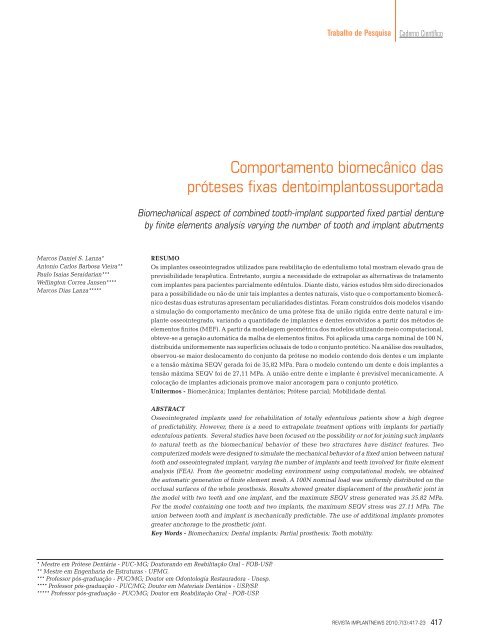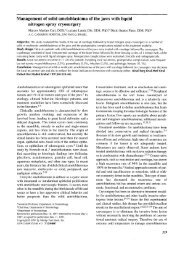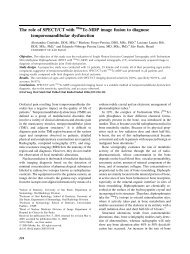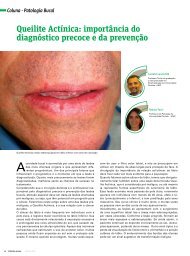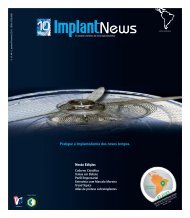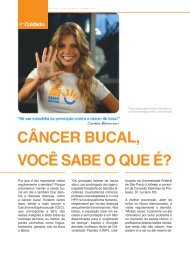7520-Revista V.7-n.3.indd - CLINICA DE ESTOMATOLOGIA ...
7520-Revista V.7-n.3.indd - CLINICA DE ESTOMATOLOGIA ...
7520-Revista V.7-n.3.indd - CLINICA DE ESTOMATOLOGIA ...
Create successful ePaper yourself
Turn your PDF publications into a flip-book with our unique Google optimized e-Paper software.
Marcos Daniel S. Lanza*<br />
Antonio Carlos Barbosa Vieira**<br />
Paulo Isaias Seraidarian***<br />
Wellington Correa Jansen****<br />
Marcos Dias Lanza*****<br />
Trabalho de Pesquisa<br />
Caderno Científi co<br />
Comportamento biomecânico das<br />
próteses fi xas dentoimplantossuportada<br />
Biomechanical aspect of combined tooth-implant supported fi xed partial denture<br />
by fi nite elements analysis varying the number of tooth and implant abutments<br />
RESUMO<br />
Os implantes osseointegrados utilizados para reabilitação de edentulismo total mostram elevado grau de<br />
previsibilidade terapêutica. Entretanto, surgiu a necessidade de extrapolar as alternativas de tratamento<br />
com implantes para pacientes parcialmente edêntulos. Diante disto, vários estudos têm sido direcionados<br />
para a possibilidade ou não de unir tais implantes a dentes naturais, visto que o comportamento biomecânico<br />
destas duas estruturas apresentam peculiaridades distintas. Foram construídos dois modelos visando<br />
a simulação do comportamento mecânico de uma prótese fi xa de união rígida entre dente natural e implante<br />
osseointegrado, variando a quantidade de implantes e dentes envolvidos a partir dos métodos de<br />
elementos fi nitos (MEF). A partir da modelagem geométrica dos modelos utilizando meio computacional,<br />
obteve-se a geração automática da malha de elementos fi nitos. Foi aplicada uma carga nominal de 100 N,<br />
distribuída uniformemente nas superfícies oclusais de todo o conjunto protético. Na análise dos resultados,<br />
observou-se maior deslocamento do conjunto da prótese no modelo contendo dois dentes e um implante<br />
e a tensão máxima SEQV gerada foi de 35,82 MPa. Para o modelo contendo um dente e dois implantes a<br />
tensão máxima SEQV foi de 27,11 MPa. A união entre dente e implante é previsível mecanicamente. A<br />
colocação de implantes adicionais promove maior ancoragem para o conjunto protético.<br />
Unitermos - Biomecânica; Implantes dentários; Prótese parcial; Mobilidade dental.<br />
ABSTRACT<br />
Osseointegrated implants used for rehabilitation of totally edentulous patients show a high degree<br />
of predictability. However, there is a need to extrapolate treatment options with implants for partially<br />
edentulous patients. Several studies have been focused on the possibility or not for joining such implants<br />
to natural teeth as the biomechanical behavior of these two structures have distinct features. Two<br />
computerized models were designed to simulate the mechanical behavior of a fi xed union between natural<br />
tooth and osseointegrated implant, varying the number of implants and teeth involved for fi nite element<br />
analysis (FEA). From the geometric modeling environment using computational models, we obtained<br />
the automatic generation of fi nite element mesh. A 100N nominal load was uniformly distributed on the<br />
occlusal surfaces of the whole prosthesis. Results showed greater displacement of the prosthetic joint in<br />
the model with two teeth and one implant, and the maximum SEQV stress generated was 35.82 MPa.<br />
For the model containing one tooth and two implants, the maximum SEQV stress was 27.11 MPa. The<br />
union between tooth and implant is mechanically predictable. The use of additional implants promotes<br />
greater anchorage to the prosthetic joint.<br />
Key Words - Biomechanics; Dental implants; Partial prosthesis; Tooth mobility.<br />
* Mestre em Prótese Dentária - PUC-MG; Doutorando em Reabilitação Oral - FOB-USP.<br />
** Mestre em Engenharia de Estruturas - UFMG.<br />
*** Professor pós-graduação - PUC/MG; Doutor em Odontologia Restauradora - Unesp.<br />
**** Professor pós-graduação - PUC/MG; Doutor em Materiais Dentários - USP/SP.<br />
***** Professor pós-graduação - PUC/MG; Doutor em Reabilitação Oral - FOB-USP.<br />
REVISTA IMPLANTNEWS 2010;7(3):417-23<br />
417


